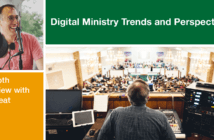Lovett Weems says the pandemic reveals the importance of certain essential financial practices for churches. Maintaining a reserve fund, expanding giving options, and setting realistic budgets can help a congregation weather tough times.
The COVID-19 pandemic has brought tragedy and hardship to millions of persons throughout the world. Among them are church members who are experiencing grief, financial loss, and pain. In the midst of the tragedy, congregations are facing many kinds of challenges. One is maintaining financial resources for the healing that is critical at this time in history and also for undergirding the witness and mission to which the church is continually called.
The pandemic and its required stay-at-home and social distancing mandates have reminded church leaders of essential financial practices we knew were important but may have never appreciated just how important.
Reserve fund
Each church needs a reserve fund with clear policies governing its size and use. A goal for the size of the reserve fund should be based on an objective standard, for example maintaining a reserve equivalent to three months to six months operating expenses. Policies for its use may be similar to the way a family would use an emergency fund — for financial needs that could not be anticipated. Such a need might be, for example, the result of a recession, the closing of a large employer in the community, or a legal judgment against the church. The reserve fund also can help meet cash flow challenges during certain times of the year. A church should resist the temptation to put too much or too little into the reserve. To that end, policies can indicate how the reserve is funded until it reaches its goal and what to do when the fund needs to be replenished or drawn down. Once the goal is reached, any additional funds need a better use than building up the reserve beyond necessity.
Multiple means of giving
Every church needs a page on its website and a brochure on “Ways to Give: How You Can Give to God’s Work through Our Church.” Many churches went into the pandemic with a limited list of options. For some, it was only:
- In each worship service you have an opportunity to give during the offering.
- You may mail a check to this address….
- You may bring your gift to the church office.
Quite apart from the pandemic, there has been a major decline in the use of checks in recent years while consumer dependence on electronic payments continues to rise. The Federal Reserve reported that from 2000 to 2015, the number of checks written by consumers fell from 19.3 billion to 7.1 billion. A recent research report by the Fed found that 39 percent of adults did not write a check over the previous year. The data, which was collected for 2018 and 2019, also showed that 12 percent of these checks went to charitable and religious institutions and that roughly a third of all payments made to charities and religious institutions were made by check.
In recent years and especially in recent weeks, churches have had to reassess their giving options. There is a reason why movie theaters do not limit patrons to one or two opportunities per week to watch a movie and utilities do not require all customers to come to their offices to pay. For people today, options are expected and appreciated.
The options for church contributions run the gamut from low-tech to high-tech. They can begin with members setting up an automated payment from their bank account each month or using their bank’s online bill pay service. More high-tech options include online giving using your church’s website or other mechanisms, such as apps, commonly used by many, especially the young.
Source of cash for emergencies
Even with a balanced budget, there will be months within the year when expenses exceed income. A cash flow budget is an internal budget tool that anticipates the receipt of income from all sources by month, as well as projecting in which months various expenses occur. The cash flow budget permits a church to anticipate when additional cash may be needed and plan a source for those funds (if enough surplus income over expenses has not built up already during the year). Cash in reserve funds or elsewhere may be permitted for temporary cash flow purposes. In addition, COVID-19 reminds us to have a contingency plan even beyond the reserve fund — perhaps a line of credit at the bank as an emergency option.
Avoid living so close to the edge
Churches are notorious for living close to the edge of financial viability. Part of the reason is that the nature of voluntary organizations is to depend on contributions. However, clergy and lay leadership have not always carefully held the tension between taking financial risks and foolishness. It serves no purpose to pass unrealistic, unachievable budgets. We can still encourage everyone to increase their faithfulness and stewardship but use the fruits of such discipleship when the money arrives — not when it exists only in our hopes. There is no set formula to follow, but most of us can determine, in conversation with wise and spiritually mature leaders, where visionary challenge ends and careless recklessness begins.
Looking ahead
The pressing needs of the moment will continue to demand our energy and attention, our prayers, and our action. The challenges are great and will become even more difficult before any sense of normalcy returns. And many have said there will be no return to normalcy if by that we mean things will be just as they were before the pandemic. But there will be a temptation to repeat some of the past mistakes and oversights when it comes to responsible church fiscal management. In the coming years, let us develop our planning with wise fiscal approaches before us. With God’s help, we have an opportunity to regroup, take stock of what has happened, and look ahead to a new day.
Related Resources
- Protect, Sustain, Grow: Best Practices for Handling Your Church’s Money Video Tool Kit
- 7 Ways to Keep Revenue and Donations Flowing During the COVID-19 Crisis by Rob Blezard
- Now is the Time to Ask Contributors to Set up Recurring Online Gifts by Lovett H. Weems Jr. and Ann A. Michel






